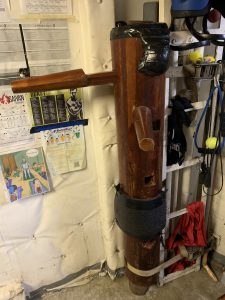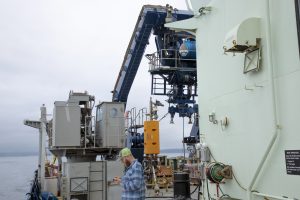July 4, 2019
A 4 a.m. shift in the control van usually isn’t an exciting thing; you’d lose your chance to see the sunrise and feel like 8pm when it’s 8am. To make things even better, if you wake up late for a 4 a.m. shift and try to hurry, you’d also get a greatly increased chance of stubbing your toes on your way down your bunk bed, leaving your phone in your room on your way out, and forgetting the policy that you should not run on the ship. Of course I didn’t wake up late for my shift though, so nothing I mentioned above happened to me.
Multiple days of dives has attuned me to life at sea, at least to some extent. It’s always somewhat similar to [4-hr shift] – [food] – [nap] – [food] – [another shift] – [food] and cycles back. Sometimes I also get a moment or two of finding a puddle of water out on the deck and stopping to wonder: “how did this water get on the deck? It can’t be the waves because the hull is too high from the waterline for waves to climb”, or I might just be unwilling to believe that I missed all the waves that were big enough to get on the deck. But mostly, the exciting parts of my day are the time I spend seeing the incredible underwater world in the control van; it’s the kind of scenery that I never get tired of, although time that JASON spends descending down there wasn’t part of it; those are hour-long intervals of staring at an array of near-still displays, except for the screen with the depth meter which seemed to be there just to be a loading bar which, upon completion, signals the beginning of the fun.

In the most recent couple of days I’ve been trying to fit a gym session into my schedule, and to my surprise, there actually are a lot more interesting stuff than what I thought there were by taking a vague look earlier. In fact, I found a wooden man post, which is used in a style of Chinese traditional martial arts as a dummy target, or a Chinese version of punching bag. I attached a picture of it below; it does have some missing arms and legs, but hey, you can’t ask much from a gym converted from what seems to be a warehouse on a ship. It was a rare enough find.
July 3, 2019
After 3 profiler swaps, we’ve finally the reached the hydrothermal fields where things get a lot more interesting. Of course, profilers are fun and all but until we crack open its shell and have an expert take a peek of the data inside, they are nothing more than bulky yellow capsules.
On the other hand, hydrothermal sites offered spectacular views even to the untrained eyes. Lava in underwater volcanos boiled surrounding water to more than 300 degrees Celsius – 3 times the boiling temperature of water at sea level – and released them through hydrothermal vents that poked out from the sea floor. Such difference in temperature was surely enough to generate refraction, giving the water stream a smoky look, which corresponded to another name of theirs, chimneys. Adding more to the scene, countless swarms of pieces of bacterial mats floated around the site like snowflakes on snow days, except that they had more variations in color. During its mission, JASON took a lot of water samples which are to be examined later. And to be honest, some of them truly smelled nasty. I’ve been seeing the ocean as one giant puddle of water which, because of its volume, can neutralize all kinds of liquid into mere salty water, but theses samples collected before they can dissolve really showed me how “pure” liquids at sea bottom can be.
July 2, 2019
Early this morning was the dive at Slope Base, with the objective of swapping the second deep profiler during the cruise which fortunately ended before my shift so there wasn’t a shift for me, otherwise I would’ve been late for it because I overslept. From the second profiler site to the third is a 17-hour transit, during which I had no mandatory work to invest my time in; it’s a good chance to poke around and get to know Atlantis a little better.
I started by visiting chambers on the lower deck and soon located the laundry room, cleaning supplies, the engine room which is a restricted area, and most interestingly, with the help from Katie and Eve, two makeshift gyms equipped with some dated yet usable weights and facilities. I am no seasoned bodybuilder, but exercising is just one thing that I’m trying to integrate into my routine. The 2 gyms had dumbbells that go as high as 40 lbs., one bar, some barbell weights and a couple of treadmills where all the iron components are rusty, but it wasn’t a problem for me; on the contrary, the touch and feel of ferric oxide actually add to this vibe of life at sea that I enjoy.
In the afternoon the sun revealed itself from the cover of clouds for the first time since the beginning of this cruise. The ocean no longer carried a grim and grey tint as it was reflecting the sky instead of the clouds. Watching water has always been one thing that I quite enjoy: the sound and motion of waves climbing over one another feels calm and tranquil; with a touch of blue hue, it simply was a setting that I couldn’t get tired of. Of course, an addition of a whale of some other magical creature into the scene would make it even better, but I don’t ask for too much.

Being onboard Atlantis, as compared to being onboard any of her sister ships, Thomas G. Thompson for example, is different not only by having a shorter name to deal with, but also by the gear they carry: Atlantis is in fact the mother ship of ALVIN, a 3-person submersible vehicle that can operate completely independent of Atlantis for science missions; I had a tour of it later the day. The vehicle was just amazing in a lot of ways; it’s got multiple, separate hydraulic systems, intricately designed failsafe measures, responsive robotic arms and, most importantly, a ridiculous number of switches, buttons, controllers, and even canisters in the cockpit (there is a picture below) Even without understanding the design, it is a visual satisfaction if one simply sits in the cockpit. It would be an incredible experience to see it in action, but unfortunately there is no mission scheduled for it in this cruise.
July 1, 2019

At about 6 or 6:30 this morning, I was awakened by an extended loud noise which sounded to be beneath the berthing quarters. Immediately I thought that was the sound of the engine starting up. However, it seemed like just an engine test or something, because I didn’t feel any movement in my cabin. I got up anyway; I didn’t want to miss the moment when the ship starts cruising.
After about an hour spent in the main lab, it was time for breakfast. At the mess deck I met Eve, my fellow student sailor who also happens to be a veteran in cruises like this. I asked her for when the ship would be moving; she told me that the ship was already in transit. That was a little bit of surprise indeed; I stood up from my seat, peeked out from a tiny window and saw that the water was actually moving backwards in my line of sight. The giant Atlantis with 274 feet of LOA and a 52.5 feet beam was traversing the ocean while staying steady like a car parked in a garage. Almost as soon as I peeked out, seasickness struck as my space perception got thrown into asynchrony. Dizzy and disoriented, I decided to step out onto the deck and see if this sickness would get any better, and it surely did. The wind blowing on the deck, thanks to the 11-kt cruising speed of the ship, was refreshing albeit a little chilly. And out in the horizon appeared… the horizon! A straight “horizontal” line that runs left to right in my field of vision, with absolutely no visible lands or other objects that would compromise its beauty, was just a treat to the eyes, plus staring at it helps with seasickness. 🙂
Later in the day, I had my first shift of logging as JASON initiated its first dive of Leg 4. As a member in the science group, I knew I should’ve paid more attention to the job itself, but I just couldn’t help getting distracted by all the fishes. Colonies of fishes swarmed at the bottom of the ocean where sunlight cannot reach and seemed attracted by the lights that JASON carried, or something else – it’s totally reasonable if they have no senses for light, since they may spend their lives without bumping into any. The mission of swapping profilers itself seemed to be a smooth ride: it’s simply recovering the old and heavy yellow cylindrical object and installing a new one, which is actually more technical than it sounds since the operation happened at the bottom of the ocean. However, if there is one thing that I was most impressed by, it’s the fact that the JASON operators here actually cared enough to spend half an hour cleaning the line where the old profiler was installed, with a brush. I know there can very well be practical reasons, but a moment when cutting-edge technologies turn to a primitive approach is surely one fun moment that I wouldn’t miss.
